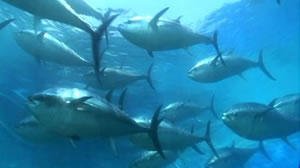True bluefin: The breeding scheme promising a future for tuna

date: 03/12/2013
Project: From capture based to self-sustained aqu...
acronym: SELFDOTT
See also: Info-Centre
Contact: http://www.ieo.es/inicial.htm
Known as the tiger of the sea, the bluefin tuna or Thunnus thynnus, can grow to more than half a tonne, glide at speeds of up to 70km/hour, and migrate over thousands of kilometres. But for many people, the bluefin’s majesty and grace in the water count for far less than the delicious taste of its rich, creamy red flesh: in January 2012, a 269kg bluefin tuna fetched a record 56.49 million yen (€564,000) at a Tsukiji market auction in Tokyo. Demand for the lucrative fish is driving it to extinction: despite global initiatives to limit the hunting, bluefin tuna populations have fallen an estimated 80% since 1970.
Until now, scientists have been unable to rear bluefins in captivity. However, a European initiative has announced a breakthrough that could set the tuna on the path to recovery. A project called SELFDOTT (Self-sustained Aquaculture and Domestication of Bluefin Tuna) has succeeded in breeding Atlantic bluefin in floating cages without the use of hormones.
After four years of research involving 13 institutes across Europe, researchers gleaned a viable mass of eggs from bluefin tuna in captivity. Raised in captivity by the Spanish Institute of Oceanography (IEO) – which is coordinating SELFDOTT – the larval rearing grew to over 1kg in just over three months. Aided by a €3 million research grant from the European Commission, the project expects many of the juvenile bluefins to reach adulthood within four years and reproduce, therefore completing the biological life cycle of this species in captivity.
The project could have huge implications for bluefin. Although the runaway market for sushi has driven the global tuna glut, Europeans have also developed a huge appetite for the fish, and European trawlers have been amongst the most active tuna hunters. Recent moratoriums could help rebuild stocks, but bluefin breeding would speed the recovery.
SELFDOTT project coordinator Fernando de la Gándara, a senior IEO researcher who has been involved in efforts to domesticate bluefins for over a decade, says the team had to cater for the special requirements of the fish, including its huge size, and its practice of roaming freely over the open ocean. “The word "obstacle” does not exist in the bluefin tuna’s vocabulary,” de la Gándara says. “We have had to cope with a high mortality rate because of collisions against the walls and net of the tanks and cages.”
But the persistence paid off, and two years ago the project celebrated its first spontaneous, massive spawning. “It was a big and happy surprise,” de la Gándara says. “We have learnt that bluefin tuna rearing is possible in the same way that you can breed other species like sea bass, turbot or salmon.”
It will still take time to develop the farmed tuna: the fish needs a decade or more to mature. But de la Gándara says that if it succeeds, it could represent a vital step in the global efforts to rebuild bluefin tuna stocks. “The bluefin tuna is an emblematic species that has been feeding Mediterranean populations for thousands of years. This project could help continue the tradition,” he says. As for the research, de la Gándara admits that he still has a lot more to learn from the bluefin. “I can see that the more I study this species, the more I love it,” he says.
